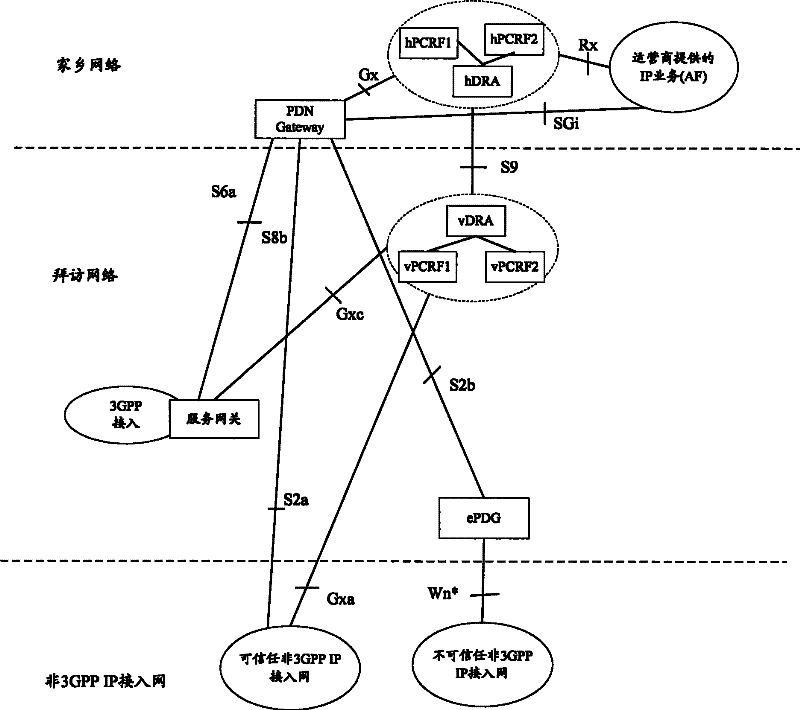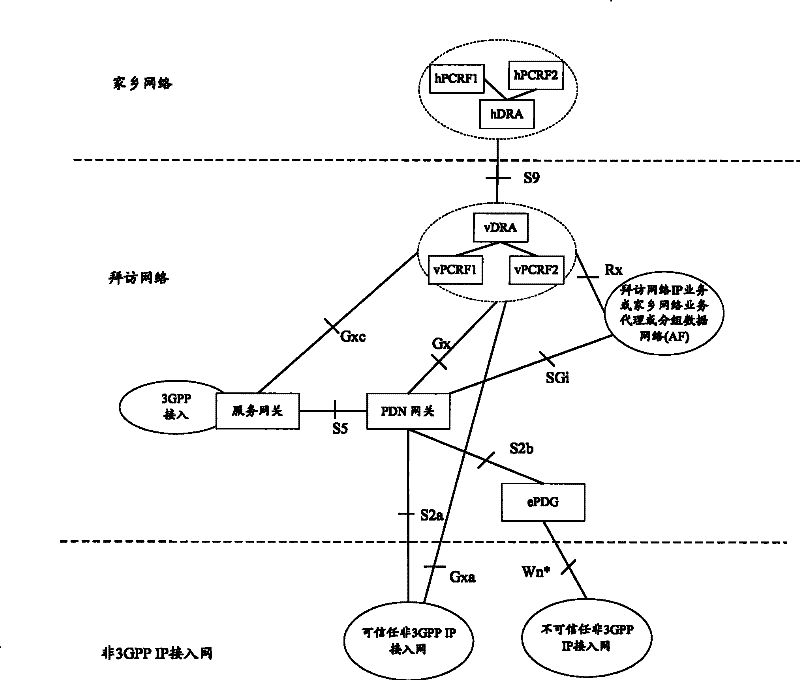Providing method of user equipment (UE) IP address and Diameter routing agent
A technology of IP address and user equipment, applied in the field of communication, can solve the problem that DRA cannot find PCRF correctly, and achieve the effect of dynamic policy charging control
- Summary
- Abstract
- Description
- Claims
- Application Information
AI Technical Summary
Problems solved by technology
Method used
Image
Examples
Embodiment 1
[0071] This embodiment describes the process of establishing an IP-CAN session when the UE accesses the EPC through a trusted non-3GPP access system or E-UTRAN in a non-roaming architecture and adopts PMIPv6. Figure 5 A flow chart of the method for providing the IP address of the UE in Embodiment 1 of the present invention, such as Figure 5 shown, including the following steps:
[0072] Step S501, the S-GW or the trusted non-3GPP access gateway residing with the BBERF function receives an IP-CAN session establishment request message, and the S-GW or the trusted non-3GPP access gateway obtains the UE's identification NAI, PDN Identification, IPv6 address request, and access information for formulating policies, etc.;
[0073] Step S502, BBERF, DRA, and PCRF interact to execute the gateway control session establishment process, which specifically includes: BBERF sends a "gateway control session establishment instruction" message to DRA, and carries the UE's identifier NAI and...
Embodiment 2
[0096] This embodiment describes that the UE accesses the EPC through a trusted non-3GPP access system or E-UTRAN under a non-roaming architecture, and uses PMIPv6. After the IP-CAN session establishment process in Embodiment 1, the P-GW initiates the release Flow for IPv4 addresses. Image 6 A flow chart of the method for providing the IP address of the UE in Embodiment 2 of the present invention, such as Image 6 shown, including the following steps:
[0097] Step S601, when the UE releases the IPv4 address or the IPv4 address expires, the P-GW initiates the IPv4 address deletion process; the PCEF sends the "IP-CAN Session Modification Instruction" message to the DRA, which carries information indicating the deletion of the IPv4 address. The information can be explicit or implicit; the "IP-CAN Session Modification Indication" message can be a Diameter CCR message during implementation, where the CC-Request-Type AVP is set to "UPDATE_REQUEST";
[0098] Step S602, the DRA up...
Embodiment 3
[0110] This embodiment describes the process of establishing an IP-CAN session when the UE accesses the EPC through a trusted non-3GPP access system or E-UTRAN under the roaming architecture of local grooming and adopts PMIPv6. Figure 7 A flow chart of the method for providing the IP address of the UE in Embodiment 3 of the present invention; Figure 7 shown, including the following steps:
[0111] Step S701-step S713 and Figure 4 The steps S401-step S413 are the same, and will not be repeated here;
[0112] Step S714, after the vPCRF receives the request message, it sends the "S9 Session Modification Indication Request" message to hDRA, and carries the NAI, PDN identifier and UE's IP address in it; the S9 Session Modification Indication Request message can be DiameterCCR in the implementation process message, wherein the CC-Request-Type AVP is set to "UPDATE_REQUEST"; it should be noted that vPCRF can also use a customized specific message to notify hDRA of the IP address...
PUM
 Login to View More
Login to View More Abstract
Description
Claims
Application Information
 Login to View More
Login to View More - R&D Engineer
- R&D Manager
- IP Professional
- Industry Leading Data Capabilities
- Powerful AI technology
- Patent DNA Extraction
Browse by: Latest US Patents, China's latest patents, Technical Efficacy Thesaurus, Application Domain, Technology Topic, Popular Technical Reports.
© 2024 PatSnap. All rights reserved.Legal|Privacy policy|Modern Slavery Act Transparency Statement|Sitemap|About US| Contact US: help@patsnap.com










